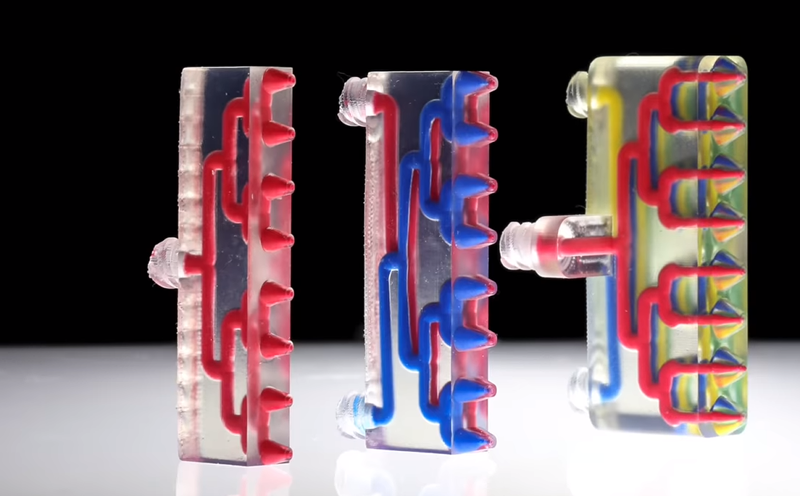When you zoom in on a fractal you find it is made of more fractals. Perhaps that helped inspire the Harvard 3D printers that have various arrays of mixing nozzles. In the video below you can see some of the interesting things you can do with an array of mixing nozzles. The coolest, we think, is a little multi-legged robot that uses vacuum to ambulate across the bench. The paper, however, is behind a paywall.
There are really two ideas here. Mixing nozzles are nothing new. Usually, you use them to mimic a printer with two hot ends. That is, you print one material at a time and purge the old filament out when switching to the new filament. This is often simpler than using two heads because with a two head arrangement, both the heads have to be at the same height, you must know the precise offset between the heads, and you generally lose some print space since the right head can’t cross the left head and vice versa. Add more heads, and you multiply those problems. We’ve also seen mixing nozzles provide different colors.
The printers in the video, can lay down filament of different types and achieves very rapid change overs. According to the authors:
… exploit(s) the diode-like behaviour that arises when multiple visco-elastic materials converge at a junction to enable seamless, high-frequency switching between up to eight different materials…
This should be within reach of existing hobby-level mixing hot ends, although perhaps it requires different materials than we currently use.
In addition to the robot, there is a folding origami-like structure that uses both rigid and flexible plastic. The only thing that struck us is that while the array of nozzles makes fast prints with repetitive structure, it didn’t seem possible to turn them off. So the things you could print with, say, an 8-head nozzle would be very limited by the spacing between the nozzles since all the nozzles print together.
Still, this could be a good research project for anyone with a mixing hotend. The capability is even available on tiny printers. If you want to mix four filaments, there’s always the diamond. If you get results — positive or negative — experimenting with this technique, write it up, hit us with a tip, and we’ll pass it along.
















Even if you could turn off the extra nozzles you would still have the problem of multiple extruders needing perfectly matching height from the build plate to avoid interference as the ‘off’ nozzle crosses the work. Or you are just printing to the same share of the print bed so gaining nothing but the ability to print the same thing less times. (Though that could still be a great time saver letting one specialized machine build n sizes of that crawling actuator for example just by turning off nozzles.)
You could potentially do it like they do with build platforms on cheap resin printers: a swivel that lets you land on the plate evenly then lock into place.
That could help but in my experience with multiple hot ends it would not be enough for great prints still as the bed is never perfectly flat or parallel to the head travel so if a nozzle ever crosses a neighboring heads print it can damage or even knock of the part from the bed. Its remarkable how little the tolerance in that setup is. Great when you do get it working well enough though.
Maybe I’m not understanding what you’re talking about. If your point is that there are multiple heads, why couldn’t a single head with multiple injections not be made?
You would literally change out the head depending on the size of work that needs to be done.
Again, maybe I’m not understanding what you mean.
I wonder what type of material they print. it looks like a plastic 3d printed nozzle, so it must be some uv curing gel type plastic.
It’s stereolithic-ly printed (the nozzle), but I think they’re using some kind of silicone + wax material.
I don’t see any reason why it couldn’t be converted to a traditional hot-end, although the system is heavily pressure-reliant, so I don’t know how you’d feed filament.
3D printers are more affordable manufacturing, and education than ever
And if you want to actually mix filaments without the Colgate effect..
https://hackaday.io/project/20763